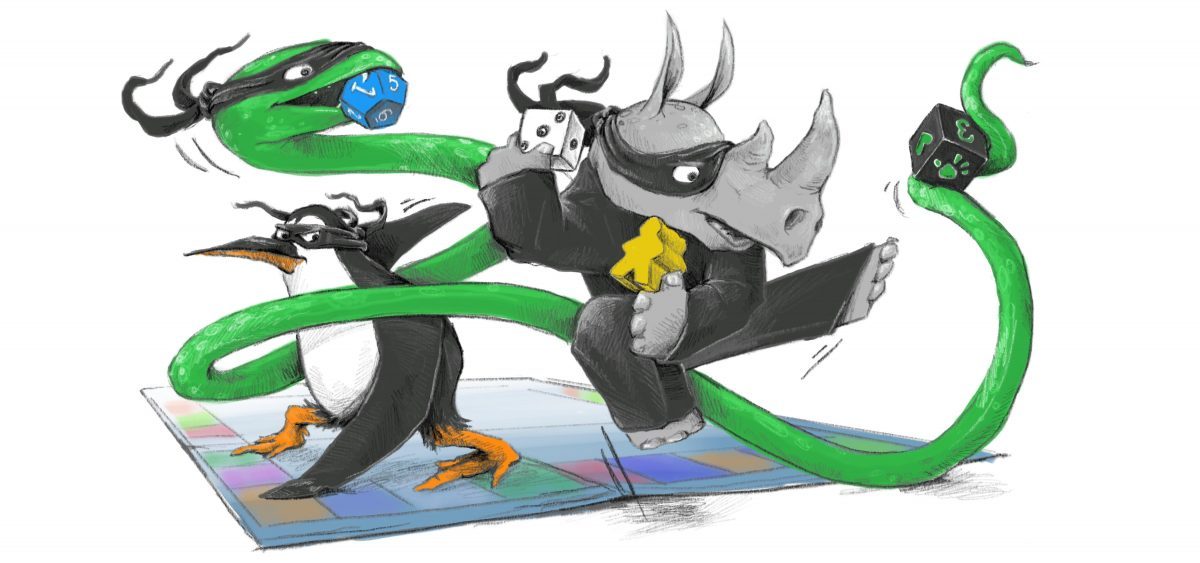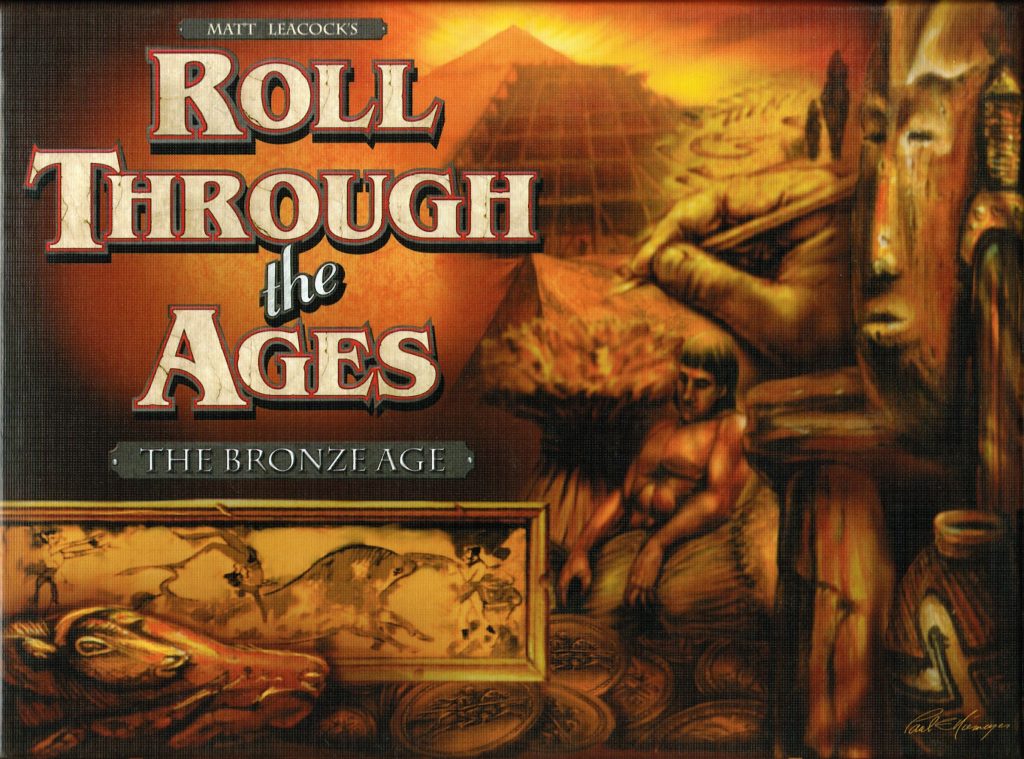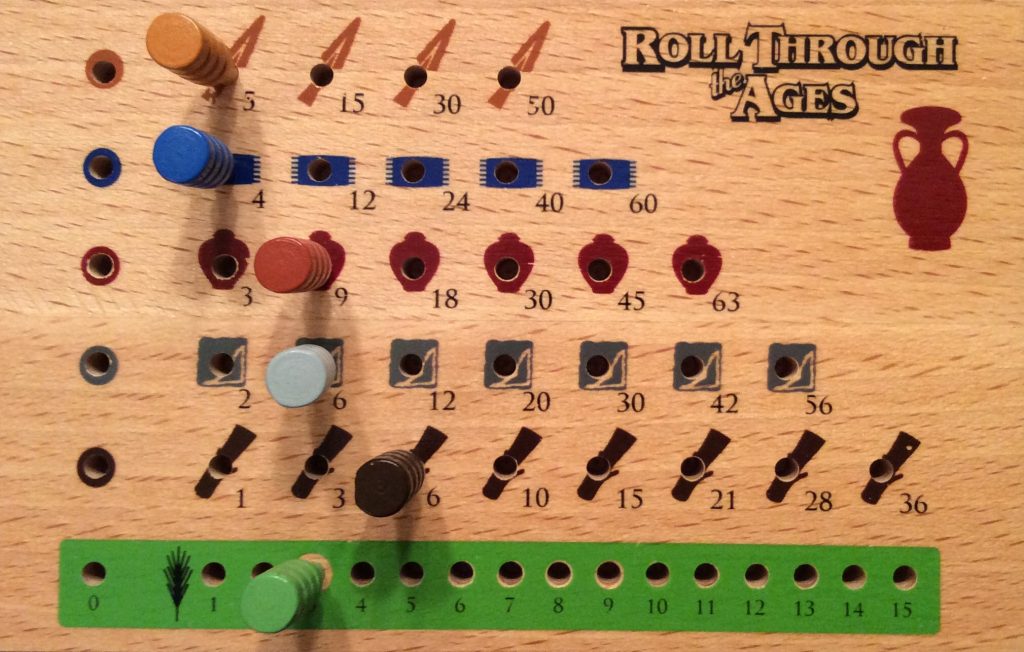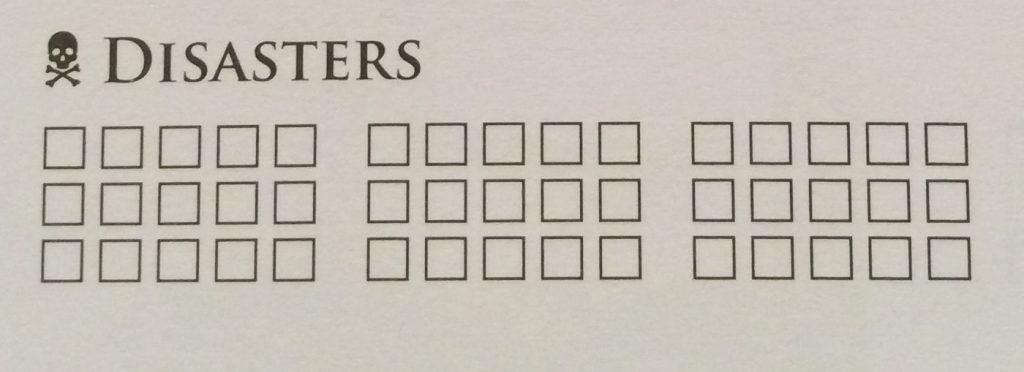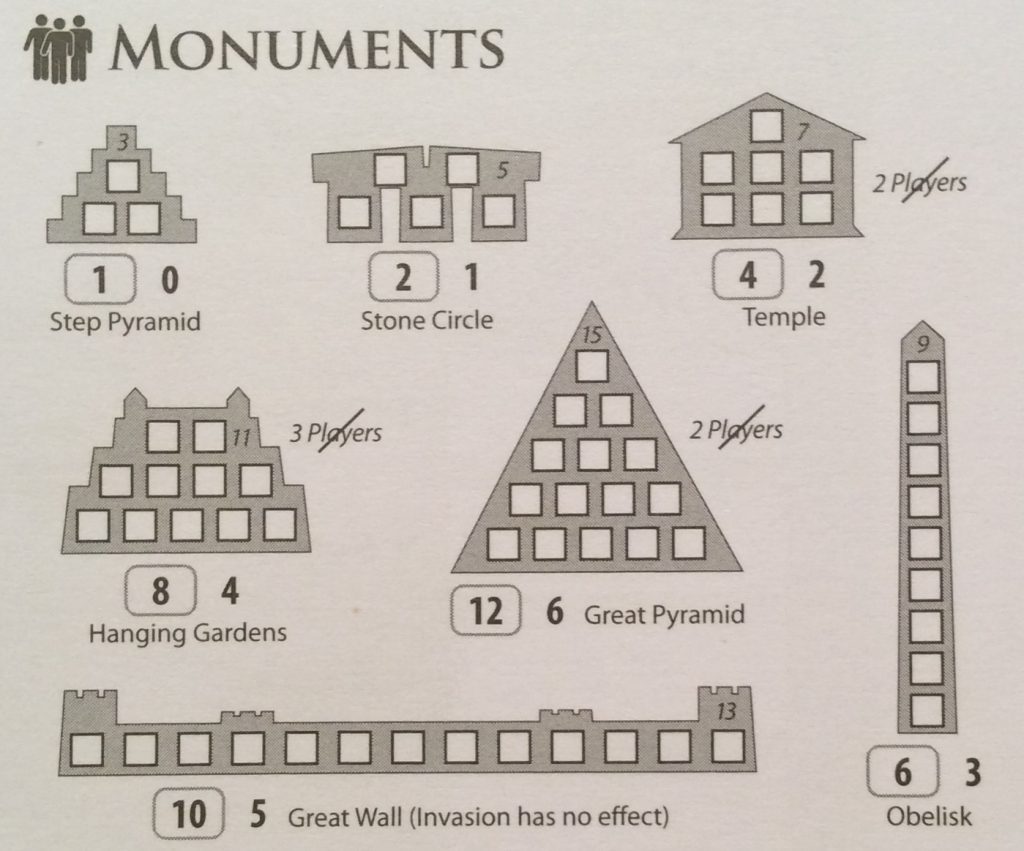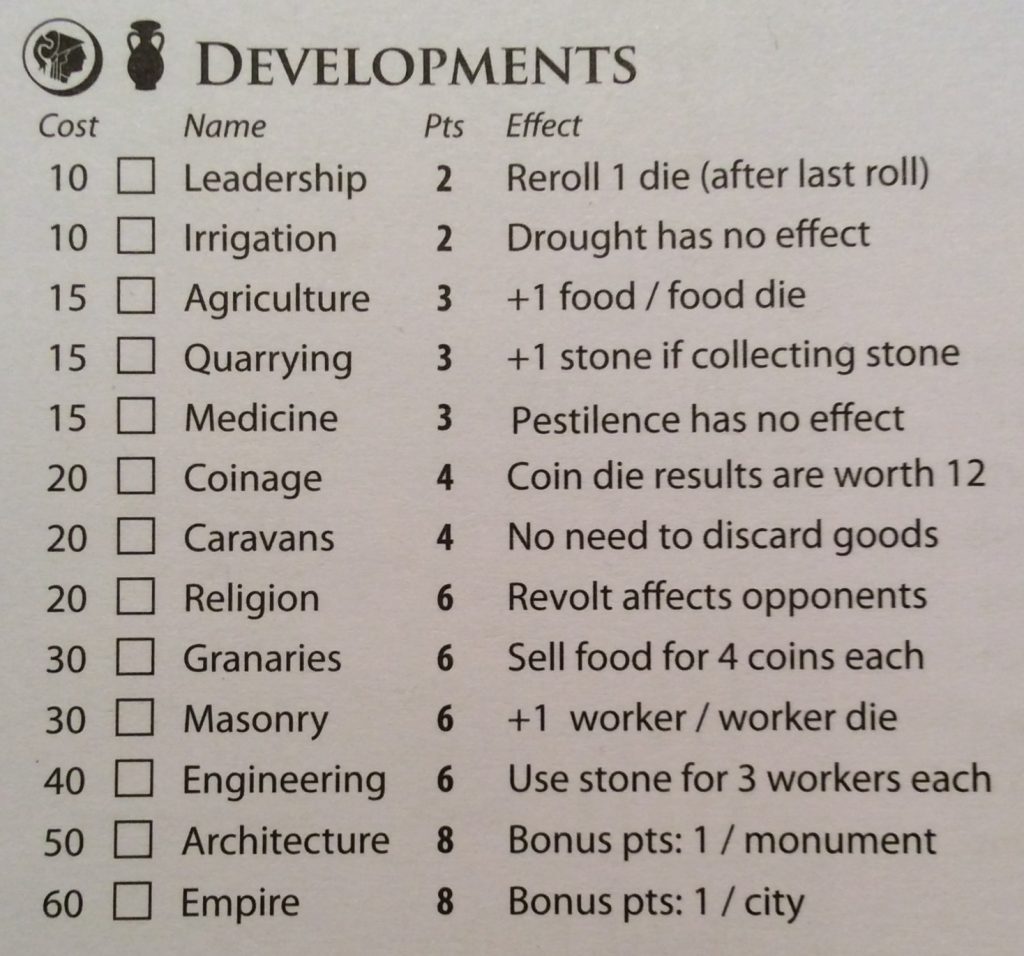So … I absolutely love Pandemic. I don’t think there is a game that me and my wife have played more. So when I found out that Matt Leacock was behind Roll Through the Ages I was immediately excited. But I was just a tad bit worried when I opened the box, because honestly there isn’t much to this game component wise. Basically there are just 7 dice, 1 pegboard for each player, some pegs to go with them and some scoresheets to keep track of everything.
Turns out that’s all you need. You see, this game disguises itself as a simple dice game but has infinitely more to offer.
But since you haven’t played it, you probably need some convincing. So, let me try to explain:
At first glance, Roll Through the Ages’ gameplay sounds a lot like King of Tokyo or Yahtzee. You roll your dice, keep the ones you want, reroll then do it again, keeping the third roll. But there is a much deeper aspect to consider. So, let’s take a look at the dice:
There are six different results possible: 7 Coins, 3 food, 2 food or 2 workers, 3 workers, 1 good, or 2 goods and 1 skull.
Goods and coins you use to buy developments. Food you use to feed your cities. Workers build new cities or monuments. Skulls are bad (they cannot be rerolled and lead to disasters – negative points). The amount of dice you roll each turn is based on the number of cities you have built, each player will start with 3, but this usually changes pretty fast.
So, what does a turn look like?
First you roll, reroll, then reroll again, keeping the third roll. Any food or goods that you rolled, you collect. You record them on your pegboard.
Your food total (the green track) moves up one for every food you roll. The goods move up differently. For each good you roll you move the wood peg first, then the stone, then the pottery and so forth. If you were to roll 6 goods you would then start over with wood. The lower goods you will collect more frequently but are worth less.
After you have collected and recorded food and goods, you have to feed your cities. For each city you must subtract 1 food. If you don’t have enough food to feed a city, you mark a mark on your disaster track for each one.
After paying your food cost, you need to check for other disasters (other than famine). If you have rolled more than 1 skull, you start running into problems. Each skull checks another disaster box, except for 3 skulls ( Pestilence ) which effects your opponents instead (this adds to the press your luck aspect – “if I’ve already rolled 2 skulls, I might as well try for a 3rd so that it effects my opponents instead, but what if I get 4?”).
Now you are ready to spend your goods, workers, and coins. Workers can be spent checking off boxes in either a new city (maximum of 7 cities) or a monument. Goods and coins combine to buy developments.
Cities are pretty self explanatory. Once you’ve checked all the boxes in a new city you get to roll another die each turn (maximum 7), but remember you have to have enough food to support that city, so it’s a trade off.
Momuments simply give you victory points at the end of the game with a bonus going to the first player to construct that type of monument (except for the Great Wall which also protects you from Invasion).
Developments are a bit more complicated. Each development is worth a certain number of victory points at the end of the game, but also gives you a special bonus . (Leadership lets you reroll a die an extra time, Irrigation lets you ignore Drought). These bonuses are where the true strategy comes in, allowing you to truly customize your gameplay.
Workers and coins do not carry over from round to round, so use them all. Goods are different. You can carry over 6 goods to the next round. That is 6 peg holes not 6 value. So you have to plan accordingly (Caravan allows you to ignore this rule).
Once you spend what goods, coins, and workers you have (or want to), your turn is over. The dice pass to the next player and they take their turn. Once someone builds their fifth development or all of the monuments have been built once, the game is over. Everyone adds up their score – subtracts their disasters and whoever has the highest score wins.
So that’s the basics – overall pretty straightforward.
So how’s the game play?
First off, it’s really simple to learn but very deep. You can play the game differently every time and will probably have to – due to the nature of the dice rolling. The developments allow you to customize your play to your style or just follow where the dice lead you.
The game is very well balanced. You have to pay attention to how fast you are finishing cities so that you have enough food to support them. You have to spend the goods as you get them, or plan accordingly (again Caravan can help with this). Also the skull dice will sometimes make decisions for you. If you have 1 skull die, you don’t have to mark any disasters, but as soon as you get more than 1 the disasters start coming. So sometimes when you get 1 skull die showing, it’s time to stop rolling. You can also choose to ignore the warning signs and continue pressing your luck – “Disasters? Who cares about disasters? I want my monuments built!” (Spoiler: this may lead to losing).
The timing mechanisms are fantastic. The fact that you are limited to one development per turn prevents someone from ending the game too soon or too suddenly without the other players being near finished. The monuments also provide protection against this with the game being over when one of each of the monuments are completed. But you do have to pay attention. If you aren’t, you might get caught having nothing accomplished when someone else ends the game. Paying attention to other players can become extremely difficult when 3 other players start rolling in goods and money, and you are busy handling your own business.
Which brings me to the feel. The game is designed so that it can be played solo, and it plays really well that way. I’ve played it solo probably as many times as with other players and I really like it. In fact I think the game is really well designed.
My only concern is that it plays a little too much like a solo game even when there are multiple players. There are measures in place to make the game have some interaction (one disaster effects other players instead of you) and as stated before, you have to pay attention or the game will move on without you. But, it is very possible to be waiting several minutes for your turn to come around and to get distracted (“Oh, is it my turn? What just happened?”). But, it still has a great feel to it.
Don’t get me wrong, I really like this game. I just think some people will be bothered that there isn’t more interaction.
It is a very deep game for not having many components/moving parts. The components that it does have are very good quality. The dice are larger than standard d6, but I like the feel. The pegboards are great, and there are plenty of scoresheets. The game lacks in color, but that is not super important, and the gameplay more than makes up for all this.
So, overall, it’s great. I love that every game is different. I originally thought that getting Caravan was essential, but then I tied with another player without him even considering it. I played one game without ever building all the cities, and others where that was the first thing I did. I tried building a farming system and sold off food for coins to build developments. There are lots of different paths to victory and all of them waiting to be foiled by the ever present threat of disasters. The decision making is extremely important, especially once people start really developing their strategies, because the game starts moving much faster. Only being able to build one development per turn really forces you to plan well. All of this works together to produce a very satisfying experience.
It will definitely find a place in my rotation.
A game I will come back to again and again. A truly solid game.
Ninja Approved!
Eagle-Gryphon games provided us with a copy of the game for review purposes – no other compensation was provided.
